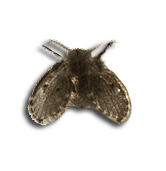Moth or 'Drain' Fly
|
General Characteristics: - Body hairy, variably yellow through gray to black; when at rest, wings held roof-like over body - Wing veins numerous, hairy, parallel, with no cross-veins in outer two-thirds of wing - Antennae long, containing 12-16 segments, each segment bulbous with ring of long hairs - Adult body length 1.5-4 mm Reproduction: - Females lay irregular masses of 30-200 eggs in the organic gelatinous film lining drains, in bathtubs and showers - Eggs hatch 32-48 hours after being laid, when ambient temperatures are 70ºF (about 20ºC), larvae pupate 9-15 days later - Pupa stage lasts 20-40 hours - Development time from egg to adult is 7-28 days, depending on temperature and food availability - Adults live for about two weeks Signs of Infestation: - Adults often found around sewage installations, in public washrooms, and bathrooms in homes, and are attracted to light - Pupae occur on the surface of the organic film that the larvae have been living in Control Techniques: - Close and seal as many openings as possible through which the flies can enter. This procedure is time consuming and may require a dedicated long term effort. - Thorough cleaning of all floor drains, including scrubbing debris from piping walls, is necessary to reduce or eliminate reproduction “Subfamily Psychodinae - Moth Fly” (On-line). Iowa State University Entomology. Accessed Jan.
|


